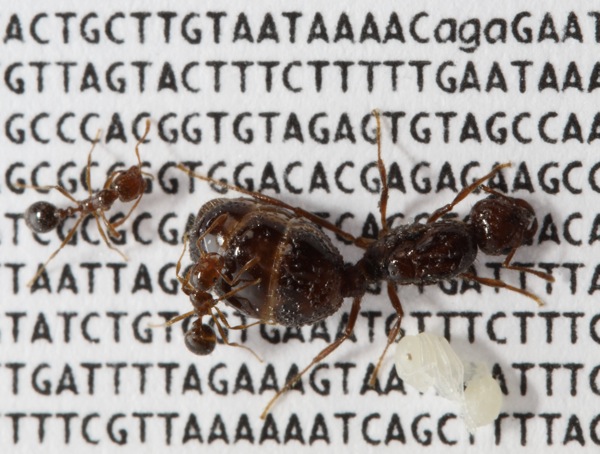Ants, Bees, Genomes & Evolution @ Queen Mary University London
Scientists find new colony structure of fire ants evolved in one species before spreading to others
Scientists from Queen Mary University of London have discovered that a new form of ant society spread across species. They found that after the new form of society evolved in one species, a “social supergene” carrying the instruction-set for the new social form spread into other species. This spread occurred through hybridisation, i.e., breeding between ants of different species. This unlikely event provides an alternate way of life, making the ants more successful than if they only had the original social form.
Red fire ants originally had only colonies with one queen. The team previously discovered that about one million years ago, a new social form evolved where colonies could have dozens of queens. A particular version of a large section of chromosome, named the “social supergene”, includes the genetic information necessary to make workers accept more than one queen. The new research, published today in Nature Communications, analysed the entire genomes or instruction sets of 365 male fire ants to examine the evolution of the social supergene, and found that the same version of this chromosome is present in multiple fire ant species.

Transfer of large amounts of genetic information across species is rare because of genetic incompatibilities. However, in this case, the advantages of having multiple queens overrode the incompatibilities, and the genetic material repeatedly spread to other species from the one source species in which this new social form evolved. The multiple-queen social form has advantages in several situations. For example, a multiple-queen colony has more workers and thus can outcompete a colony with only one queen. Furthermore, if there is a flood, a colony with multiple queens is less likely to become queenless.
Dr Yannick Wurm, Reader in Evolutionary Genomics and Bioinformatics at Queen Mary University of London and a fellow of The Alan Turing Institute said: “This research reveals how evolutionary innovations can spread across species. It also shows how evolution works at the level of DNA and chromosomes.
“It was incredibly surprising to discover that other species could acquire a new form of social organisation through hybridisation. The supergene region that creates multi-queen colonies is a large piece of chromosome that contains hundreds of genes. The many parts of a genome evolve to work together in fine-tuned manners, thus suddenly having a mix with different versions of many genes from another species is complicated and quite rare.
“Instead of executing extra queens as they would in a single-queen colony, the new version of the supergene leads workers to accept multiple queens. Having studied the history of the supergene and new social form extensively, we next want to identify which genes or parts of the supergene region, lead to these changes in behaviour. This will also help fill more gaps in our understanding of evolutionary processes.”
Rodrigo Pracana, a lead author of the study, also at Queen Mary University of London added: “Our study shows how detailed analysis of large numbers of wild animals can provide surprising new insight on how evolution works.”
The team from Queen Mary were previously among the first in the world to apply large-scale DNA-sequencing approaches to wild insects – which enabled them to discover one of the first well-known supergenes.
Red fire ants are native to South America and infamous for their painful sting. One of these species is known in many other parts of the world, where it is aggressiveness and high population density have made it an invasive pest. Efforts at controlling the spread of this species have largely been unsuccessful, as indicated by its Latin name, Solenopsis invicta, meaning “the invincible”.
The research was supported by the Leibniz Institute for the Analysis of Biodiversity Change, with Dr. Eckart Stolle assisting as part of the team at Queen Mary before continuing this work at the Leibniz Institute.
Dr Yannick Wurm is a Reader in Evolutionary Genomics and Bioinformatics at the School of Biological and Behavioural Sciences. His lab runs between Queen Mary University of London and The Alan Turing Institute. The lab studies the lives of social insects including ants and bees, and how they evolve in the face of social and environmental challenges. For this, lab members combine behavioural experiments with cutting-edge molecular approaches including genomics and bioinformatics. Find out more about the Wurm Lab.
Further information
Research publication: ‘Recurring adaptive introgression of a supergene variant that determines social organisation’ Stolle et al. Nature Communications
March 11, 2022